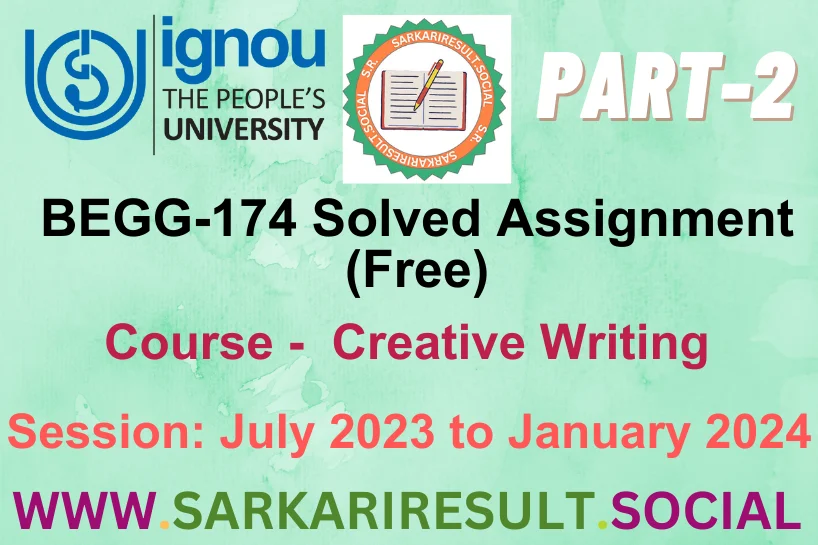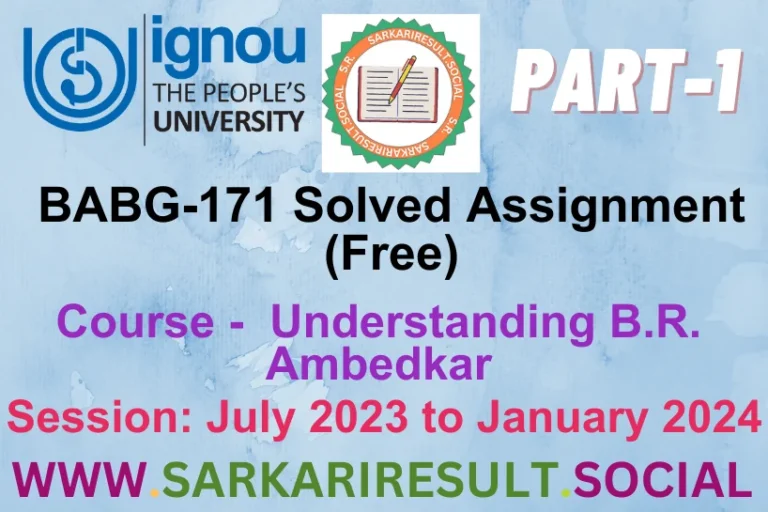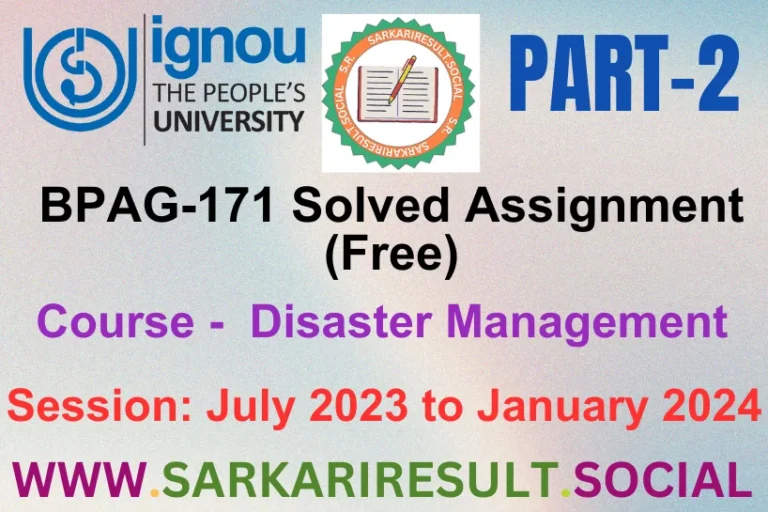BEGG 174 SOLVED IGNOU ASSIGNMENT FREE PART 2

Embark on a journey of creative exploration with BEGG 174 SOLVED IGNOU ASSIGNMENT FREE PART 2. Creative Writing, effortlessly mastering Section B through our meticulously crafted IGNOU Solved Assignments 2024. In each question, discover the keys to honing your creative craft, elegantly presented in our written format.

Q. 2 Answer the following questions in about 350 words each:
1. Dialogues help to ensure readability. Do you agree? Give reasons for your answer.
Ans. Yes, I agree that dialogues play a crucial role in ensuring readability in written content. Dialogues serve as a powerful tool to engage readers, enhance the flow of the narrative, and bring characters and situations to life. Several reasons contribute to the effectiveness of dialogues in promoting readability:
1. Conversational Nature:
Dialogues mimic real-life conversations, making the text more relatable and accessible. Readers are naturally drawn to the dynamic, back-and-forth exchange of ideas and emotions, creating a sense of immediacy and connection.
2. Character Development:
Through dialogues, characters reveal their personalities, motivations, and relationships. The way individuals speak, their choice of words, and their tone provide insights into their identities. This enriches the narrative, allowing readers to form a deeper connection with the characters.
3. Breaks Monotony:
Continuous paragraphs of descriptive text can become monotonous. Dialogues introduce breaks and variety, preventing the reader from feeling overwhelmed. The pacing becomes more dynamic, keeping the reader engaged.
4. Show, Don’t Tell:
Dialogues are an effective way to show emotions, conflicts, and resolutions. Instead of explicitly stating feelings or events, writers can let the characters’ words and interactions convey the message. This ‘show, don’t tell’ approach enhances the reader’s experience.
5. Advances Plot:
Important plot points and developments often unfold through dialogues. Characters discussing their goals, conflicts, or plans move the story forward. Dialogues provide a natural mechanism for conveying information, maintaining the reader’s interest.
6. Ease of Reading:
Dialogues often consist of shorter sentences and paragraphs, contributing to the overall readability. This is particularly beneficial for readers who prefer a more straightforward and concise writing style.
7. Facilitates White Space:
Dialogues introduce white space on the page, breaking up dense text. This formatting technique makes the content visually appealing and less daunting for readers.
8. Cultural and Regional Nuances:
Dialogues can incorporate cultural and regional nuances through language choices and expressions. This adds authenticity to the setting, creating a more immersive reading experience.
In conclusion, dialogues are instrumental in making written content more engaging, relatable, and accessible. They enhance character development, advance the plot, and provide a natural rhythm that captures and sustains the reader’s attention. The inclusion of dialogues, when done thoughtfully, significantly contributes to the overall readability of a piece of writing.
2. What guidelines should be followed for writing for online media?
Ans. Writing for online media demands a distinct set of guidelines to captivate digital audiences and accommodate the unique features of the online environment. Here are crucial guidelines to follow:
1. Clarity and Conciseness:
Online readers have limited attention spans. Clearly convey your message in concise sentences and paragraphs. Break down complex ideas into easily digestible segments.
2. Scannability:
Online content is often scanned rather than read in detail. Use subheadings, bullet points, and lists to break up content. Highlight key information to make it easy for readers to grasp the main points quickly.
3. Engaging Headlines:
Craft compelling headlines that grab attention and provide a clear idea of the content. Include relevant keywords for search engine optimization (SEO) to improve visibility.
4. Short Paragraphs:
Keep paragraphs short for easy reading on screens. White space helps prevent reader fatigue. Aim for one idea per paragraph to enhance clarity.
5. Inverted Pyramid Style:
Front-load your content with the most crucial information. The inverted pyramid style places the most important details at the beginning, followed by supporting information.
6. Hyperlink Strategy:
Use hyperlinks strategically. Link to reputable sources for credibility and provide additional information when necessary. Ensure that links open in new tabs to retain your audience.
7. Multimedia Integration:
Enhance content with visuals like images, infographics, and videos. Visual elements break up text and appeal to diverse learning styles. Optimize images for fast loading times.
8. Mobile-Friendly Format:
A significant portion of online users accesses content through mobile devices. Ensure your content is responsive and readable on various screen sizes. Test your content on different devices to guarantee a positive user experience.
9. SEO Optimization:
Incorporate relevant keywords naturally within your content for search engine optimization. Use meta descriptions and alt text for images to improve discoverability.
10. Interactive Elements:
Encourage engagement with your audience through comments, social media sharing, or interactive features. Foster a sense of community around your content.
11. Consistent Brand Voice:
Maintain a consistent brand voice across your online presence. Whether it’s a blog post, social media update, or video script, the tone should align with your brand identity.
12. Accessibility:
Ensure your content is accessible to individuals with disabilities. Use descriptive image alt text, provide transcripts for videos, and use legible fonts and colors.
By adhering to these guidelines, writers can create content that not only appeals to online audiences but also ensures a positive and engaging experience in the digital space.
3. How important are imagery and symbols while writing poetry? Give examples to illustrate your answer.
Ans. Imagery and symbols play a pivotal role in poetry, acting as powerful tools to evoke emotions, create vivid experiences, and convey complex meanings. They enhance the depth and resonance of a poem, making it a rich and immersive experience for the reader.
Importance of Imagery:
Imagery involves the use of descriptive language to create sensory experiences. It allows readers to visualize scenes, feel emotions, and connect with the poet’s message on a visceral level. Consider this excerpt from William Wordsworth’s poem “Daffodils”:
“Ten thousand saw I at a glance,
Tossing their heads in sprightly dance.”
The vivid imagery of daffodils tossing their heads in a sprightly dance creates a visual spectacle in the reader’s mind, enhancing the joy and beauty described in the poem.
Importance of Symbols:
Symbols are objects, actions, or elements in a poem that represent deeper meanings beyond their literal interpretation. They add layers of complexity and invite readers to explore various interpretations. In Robert Frost’s “The Road Not Taken,” the diverging roads symbolize life choices:
“Two roads diverged in a wood, and I—
I took the one less traveled by,
And that has made all the difference.”
Here, the roads serve as a symbol for life paths, reflecting the choices individuals make and the impact those choices have on their journeys.
Examples:
In Sylvia Plath’s “Mirror,” the mirror serves as both an image and a symbol:
“I am silver and exact. I have no preconceptions.
Whatever I see I swallow immediately
Just as it is, unmisted by love or dislike.”
Here, the mirror is not just a reflective surface but also a symbol of unfiltered truth, revealing the speaker’s struggle with self-perception and societal expectations.
In T.S. Eliot’s “The Love Song of J. Alfred Prufrock,” various images and symbols contribute to the exploration of the speaker’s inner thoughts and anxieties. The “yellow fog” and “lonely men in shirt-sleeves” paint a bleak urban landscape, symbolizing the alienation and disconnection felt by the speaker.
In conclusion, imagery and symbols are indispensable elements in poetry. They transform words into sensory experiences and unlock layers of meaning, making poetry a nuanced and powerful form of artistic expression. The use of these literary devices enriches the reader’s engagement with the poem, inviting them to explore the depths of emotion, thought, and symbolism woven into the verses.
4. What is plagiarism and why should it be avoided in writing?
Ans. Plagiarism is the act of presenting someone else’s ideas, words, or work as one’s own without proper attribution or permission. It is considered a serious ethical and academic offense. Plagiarism can take various forms, including copying and pasting from a source, paraphrasing without giving credit, or submitting someone else’s work with minor changes.
Avoiding plagiarism is crucial for several reasons:
1. Academic Integrity:
Plagiarism undermines the core principles of academic integrity. Education relies on the honest exchange of ideas, and submitting work that is not one’s own disrupts this fundamental principle.
2. Intellectual Honesty:
Writing is a form of communication that reflects an individual’s thoughts, understanding, and creativity. Plagiarism misrepresents one’s intellectual contribution and compromises the honesty of the writer.
3. Legal Consequences:
Plagiarism can have legal consequences, especially in professional and academic settings. Unauthorized use of someone else’s work can lead to legal action, particularly if the original work is copyrighted.
4. Educational Impact:
Plagiarism inhibits the educational process. Students are expected to engage with and learn from the material they encounter. Copying someone else’s work deprives them of the opportunity to develop critical thinking and analytical skills.
5. Professional Repercussions:
In the professional world, presenting others’ work as one’s own can lead to severe consequences, including damage to one’s reputation, termination of employment, or legal action.
6. Unoriginal Work:
Plagiarism results in unoriginal, uninspired work. Writing is a skill that improves through practice, and by copying others, individuals miss the chance to develop their unique voice and style.
7. Undermines Trust:
Plagiarism undermines trust in academic and professional environments. When individuals engage in dishonest practices, it erodes the trust that is essential for collaborative learning and working environments.
8. Stifles Creativity:
Writing is a creative process that involves expressing unique perspectives and ideas. Plagiarism stifles this creativity by encouraging the recycling of existing content instead of fostering original thought.
9. Academic and Professional Consequences:
Many educational institutions and workplaces have strict policies against plagiarism. Consequences may include failing grades, academic probation, or, in professional settings, loss of credibility and opportunities.
In conclusion, avoiding plagiarism is not only an ethical imperative but also essential for personal and professional growth. It upholds the principles of integrity, originality, and respect for intellectual property, fostering an environment that values honest expression and the pursuit of knowledge.
Also See This: BEGG 174 SOLVED IGNOU ASSIGNMENT FREE PART 3







